
The banded krait is a species of elapids endemic to Asia, from Indian Subcontinent through Southeast Asia to Southern China. With a maximum length exceeding 2 m, it is the longest krait with a distinguishable gold and black pattern. While this species is generally considered timid and docile, resembling other members of the genus, its venom is highly neurotoxic which is potentially lethal to humans. Although toxicity of the banded krait based upon murine LD50 experiments is lower than that of many other kraits, its venom yield is the highest due to its size.
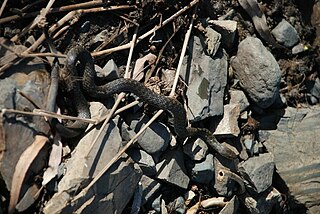
The common keelback, also known as Mair's keelback, is a species of nonvenomous snake in the family Colubridae. The species is endemic to Australasia.
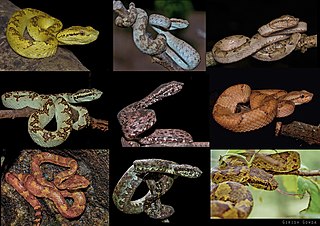
Craspedocephalusmalabaricus, commonly known as Malabar pit viper, Malabar rock pit viper, or rock viper, is a venomous pit viper species endemic to the high-moderate elevations of Western Ghats of southwestern India. Recently this species complex was split into three different species, Craspedocephalus malabaricus, Craspedocephalus travancoricus, Craspedocephalus anamallensis.
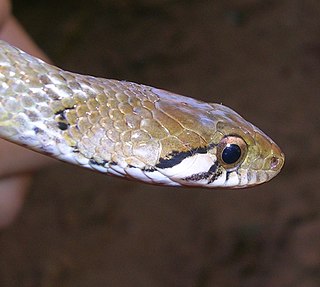
The Nilgiri keelback, also known commonly as Beddome's keelback, is a species of snake found in the Western Ghats in India. The species is named after Richard Henry Beddome, 1830–1911, British army officer and naturalist. It was first discovered near the Nilgiris but is now known more widely from the Western Ghats. This snake is terrestrial and feeds on toads.
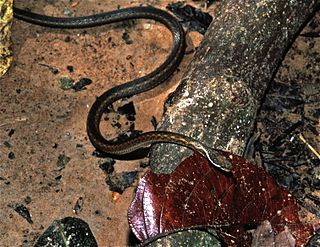
Hebius khasiensis, commonly known as the Khasi Hills keelback or Khasi keelback, is a species of colubrid snake endemic to southeastern Asia.
Hebius modestus, commonly known as the modest keelback or Günther's keelback, is a species of natricine snake endemic to Asia.

Amphiesma monticola, also known as the Wynad keelback, is a harmless colubrid snake species endemic to the Western Ghats of India, where it has been recorded in the Kodagu and Wayanad regions.

Atretium schistosum, the split keelback or olive keelback wart snake, is a species of snake found in South Asia. It is a common and harmless watersnake.
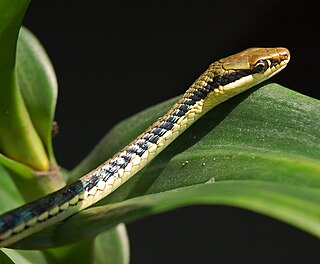
Dendrelaphis pictus, the common bronzeback, painted bronzeback, or Indonesian bronzeback, is a species of snake found in Southeast Asia and India.
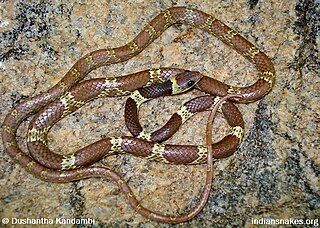
The Vellore bridal snake is a species of snake found in southern India and Sri Lanka. Bridle snakes are so named because of the resemblance of their slim bodies to the reins or 'bridle' used to control horses.

Lycodon aulicus, commonly known as the Indian wolf snake or common wolf snake, is a species of nonvenomous snake found in South Asia and Southeast Asia. Early naturalists have suggested its resemblance to the venomous common krait as an instance of Batesian mimicry.

Rhabdophis plumbicolor, known as the green keelback or lead keelback, is a species of nonvenomous snake in the family Colubridae native to parts of the Indian subcontinent.

The checkered keelback, also known commonly as the Asiatic water snake, is a common species in the subfamily Natricinae of the family Colubridae. The species is endemic to Asia. It is non-venomous.

Rhabdophis subminiatus, commonly called the red-necked keelback or red-necked keelback snake, is a species of venomous snake in the subfamily Natricinae of the family Colubridae. The species is endemic to Asia.
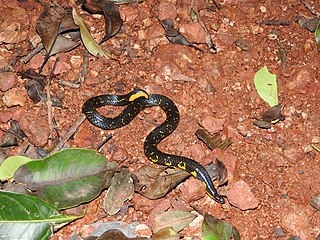
Uropeltis macrolepis, commonly known as the Bombay earth snake, the Bombay shieldtail, and the large-scaled shieldtail, is a species of snake in the family Uropeltidae. The species is endemic to southern India. There are two recognized subspecies.

Snakes, like other reptiles, have skin covered in scales. Snakes are entirely covered with scales or scutes of various shapes and sizes, known as snakeskin as a whole. A scale protects the body of the snake, aids it in locomotion, allows moisture to be retained within, alters the surface characteristics such as roughness to aid in camouflage, and in some cases even aids in prey capture. The simple or complex colouration patterns are a property of the underlying skin, but the folded nature of scaled skin allows bright skin to be concealed between scales then revealed in order to startle predators.

Coelognathus helena monticollaris is subspecies of nonvenomous constricting snake in the family Colubridae. The subspecies is native to the Western ghats of India.
The Sabah keelback is a nonvenomous colubrid endemic to Borneo.
Hebius venningi, commonly known as the Chin Hills keelback or Venning's keelback, is a species of snake in the family Colubridae. The species is endemic to Asia.

Uropeltis shorttii, also known commonly as the Shevaroy Hills earth snake and Shortt's shieldtail snake, is a species of non-venomous snake in the family Uropeltidae. The species is endemic to the southern Eastern Ghats of India. This species was first described as Silybura shorttii by British naturalist Richard Henry Beddome in 1863. It is found only in the Shevaroy Hills of Salem district in Tamil Nadu state in South India. For a long time, this species was misclassified into Uropeltis ceylanica, a snake endemic to the Western Ghats, till a recent taxonomic study proved it to be a distinct species with a very narrow geographic range. It is a burrowing snake, presumed to be nocturnal, feeding on soft-bodied worms. It becomes active during the rains. U. shorttii has most recently been assessed for The IUCN Red List of Threatened Species in 2019, and is listed as "Critically Endangered" under criteria B1ab(iii).


































